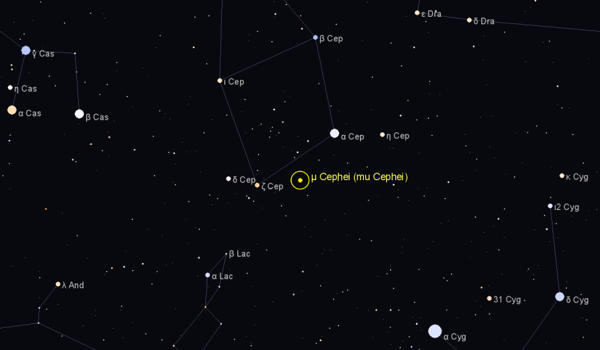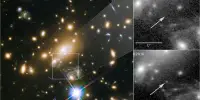Mu Cephei is a red supergiant located in the constellation Cepheus. It is also known as Herschel’s Garnet Star due to its red, garnet-like color, is a red hypergiant star in the Cepheus constellation. It is a red supergiant or hypergiant star in the constellation Cepheus. With a radius of 1,260 solar radii, or a diameter of 1,753,200,000 kilometers, it is one of the largest stars known. It appears garnet red and is located at the edge of the IC 1396 nebula. The most famous observation of this star comes from Sir William Hershel who commented on its “garnet” color, an observation that leads to the popular name “Herschel’s Garnet Star”. William Herschel (1738-1822) was probably the most famous astronomer of the 18th century.
Mu Cephei is also the “prototype” of the semiregular variable star type. It is a slow semiregular variable that is easily visible to the unaided eye in suburban skies when at its maximum brightness of magnitude 3.4, but may be a little more challenging at its minimum of 5.1. The estimated radius of Mu Cephei is between 1,260 and 1,650 times that of the Sun. It is located in the northern constellation Cepheus, in the region of the sky between Cassiopeia’s W and the Northern Cross of Cygnus.

Mu Cephei is visually nearly 100,000 times brighter than the Sun, with an absolute visual magnitude of −7.6. With an average apparent magnitude of 4.08, it is the 10th brightest star in the constellation. It is also one of the largest known stars with a radius around or over 1,000 times that of the sun (R☉), and were it placed in the Sun’s position it would engulf the orbit of Mars and Jupiter. Located at an approximate distance of 2,840 light years from Earth, it is one of the most distant stars visible without binoculars.
Mu Cephei is a variable star and the prototype of the obsolete class of the Mu Cephei variables. It is a red supergiant of the spectral type M2e Ia. It is now considered to be a semiregular variable of type SRc. It is often described as a hypergiant, a highly luminous star (luminosity class 0 or Ia+) that is rapidly losing mass due to strong stellar winds. Its apparent brightness varies erratically between magnitude 3.4 and 5.1. Many different periods have been reported, but they are consistently near 860 days or 4,400 days. If it replaced the Sun in our solar system, assuming a radius of 1,650 solar radii (7.7 astronomical units), it would extend between the orbits of Jupiter and Saturn.
A very luminous red supergiant, Mu Cephei is among the largest stars visible to the naked eye, and one of the largest known cool supergiants. In visual wavelengths, Mu Cephei is about 100,000 times brighter than the Sun. It has an absolute magnitude of -7.6. It is a runaway star with a peculiar velocity of 80.7±17.7 km/s, and has been described as a hypergiant. With an effective temperature of 3,540 K, the star shines with a luminosity between 283,000 and 340,000 times that of the Sun.
Information
















